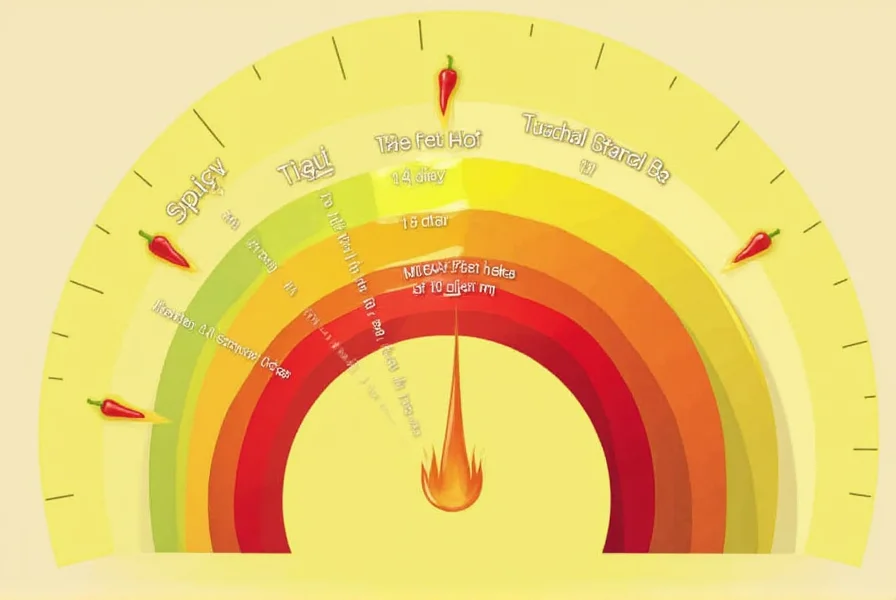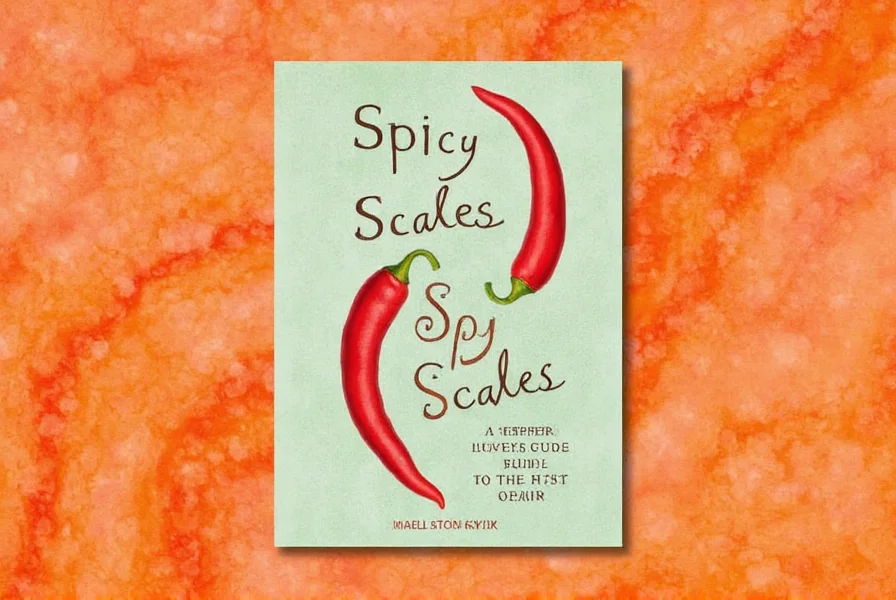Table of Contents
The History of the Scoville Scale
Developed by American pharmacist Wilbur Scoville in 1912, the Scoville scale was originally a subjective test where pepper extracts were diluted in sugar water until the heat was no longer detectable by a panel of tasters. This "Scoville Organoleptic Test" required human sensory evaluation, making it somewhat inconsistent. Today, modern laboratories use high-performance liquid chromatography (HPLC) to measure capsaicinoid concentration scientifically, then convert the results to Scoville Heat Units (SHU) for consumer understanding. This scientific approach provides much more accurate and consistent measurements than the original method.
How Scoville Heat Units Work
Scoville Heat Units measure the concentration of capsaicinoids (primarily capsaicin) in peppers. The scale is logarithmic, meaning each step represents approximately a 10x increase in heat intensity. For example, a pepper at 10,000 SHU is roughly 10 times hotter than one at 1,000 SHU. Modern testing involves extracting capsaicinoids from peppers and measuring them with HPLC equipment, then converting the concentration to SHU using a standardized formula. This scientific method eliminates the human subjectivity of the original test while maintaining the familiar SHU scale for consumers.
Pepper Heat Comparison Chart
| Pepper | Scoville Heat Units (SHU) | Heat Profile | Typical Uses | Origin |
|---|---|---|---|---|
| Bell Pepper | 0 | Mild, sweet | Salads, roasting, stuffing | Mexico |
| Poblano | 1,000-2,000 | Mild, earthy | Chiles rellenos, mole sauces | Mexico |
| Jalapeño | 2,500-8,000 | Moderate, bright | Salsas, guacamole, pickling | Mexico |
| Serrano | 10,000-25,000 | Sharp, crisp | Hot sauces, fresh salsas | Mexico |
| Thai Chili | 50,000-100,000 | Intense, fruity | Thai curries, stir-fries | Thailand |
| Habanero | 100,000-350,000 | Fiery, citrusy | Hot sauces, Caribbean dishes | Caribbean |
| Ghost Pepper (Bhut Jolokia) | 855,000-1,041,450 | Smoky, complex | Extreme hot sauces, spice challenges | India |
| Carolina Reaper | 1,569,300+ | Extreme, fruity with delayed heat | Specialty hot sauces, competitive eating | USA |
Note: SHU ranges can vary significantly based on growing conditions, soil composition, climate, and even the specific part of the pepper. The seeds and white membrane contain the highest concentration of capsaicin, while the flesh is milder.

Common Misconceptions About Pepper Heat
Several myths about pepper heat persist despite scientific evidence to the contrary:
- Myth: Removing seeds eliminates all heat - While seeds contain some capsaicin, the highest concentration is actually in the white membrane (placenta) that holds the seeds. Removing seeds alone won't significantly reduce heat.
- Myth: All peppers of the same variety have identical heat - Growing conditions dramatically affect SHU. A jalapeño grown in drought conditions can be significantly hotter than one grown with ample water.
- Myth: The hottest peppers are always the most flavorful - Many extremely hot peppers (like Carolina Reapers) have complex flavors that are often masked by the intense heat. Some milder peppers like habaneros offer more nuanced flavor profiles.
- Myth: Water helps relieve pepper burn - Capsaicin is oil-soluble, not water-soluble. Water won't effectively neutralize the burn. Dairy products containing casein are much more effective at binding to capsaicin molecules.
Safe Handling of Spicy Peppers
When working with hot peppers, proper safety precautions are essential:
- Always wear gloves - Capsaicin can transfer to your skin and cause severe irritation. Nitrile gloves provide better protection than latex.
- Never touch your face - Even a tiny amount of capsaicin in your eyes can cause significant pain and temporary blindness.
- Use ventilation - When cutting extremely hot peppers, capsaicin vapors can irritate your respiratory system. Work near an open window or use a range hood.
- Have dairy products ready - Keep milk, yogurt, or sour cream nearby to neutralize accidental exposure.
- Use dedicated cutting boards - Capsaicin can remain on surfaces for extended periods. Use a separate board for hot peppers that you clean thoroughly afterward.
- Handle with care - When using extremely hot peppers (above 100,000 SHU), consider using a mask and eye protection during preparation.

Cooking with Different Heat Levels
Understanding how heat levels interact with cooking methods can transform your dishes:
- Raw peppers deliver the most immediate heat, with the full flavor profile intact. Best for salsas, garnishes, and fresh applications.
- Roasting peppers concentrates flavors and can slightly increase perceived heat while adding smoky notes. Ideal for chiles rellenos and roasted pepper sauces.
- Boiling peppers draws out some capsaicin into the water, reducing overall heat. Useful when you want pepper flavor without intense heat.
- Fermenting peppers (as in hot sauce production) creates more complex heat sensations that develop over time. The fermentation process can also mellow some harsh edges of the heat.
- Cooking in oil distributes capsaicin more evenly throughout a dish since capsaicin is fat-soluble. This creates a more consistent heat experience than cooking in water-based liquids.
- Drying peppers concentrates capsaicin, making dried peppers significantly hotter than fresh ones. This is why dried chilies like arbol or cayenne pack such a punch.
Health Impacts of Capsaicin
Research shows capsaicin offers several health benefits when consumed in moderation:
- Metabolism boost - Capsaicin can increase metabolic rate by 5-8% for several hours after consumption
- Anti-inflammatory properties - Studies show capsaicin may help reduce inflammation markers in the body
- Pain relief - Topical capsaicin creams are FDA-approved for treating neuropathic pain
- Heart health - Regular consumption has been linked to lower blood pressure and improved cholesterol levels
- Vitamin richness - Peppers are excellent sources of vitamins A and C, with habaneros containing more vitamin C than oranges
However, those with gastrointestinal conditions like IBS or ulcers should consume spicy peppers cautiously, as capsaicin can irritate the digestive tract. Always start with milder peppers and gradually build tolerance if you're new to spicy foods.
How was the Scoville scale originally measured?
The original Scoville Organoleptic Test (1912) involved diluting pepper extracts in sugar water until the heat was no longer detectable by a panel of tasters. The number of dilutions required determined the Scoville rating. For example, if a pepper extract needed to be diluted 1,000 times before the heat was undetectable, it was rated 1,000 SHU. This method was subjective and inconsistent, leading to modern HPLC testing methods that measure capsaicin concentration scientifically.
Why do some peppers have such wide SHU ranges?
Pepper heat varies significantly due to growing conditions, soil composition, climate, and even the specific part of the pepper. For example, drought conditions increase capsaicin production as a stress response. The seeds and white membrane contain the highest concentration of capsaicin, while the flesh is milder. Even within the same pepper variety, individual peppers can vary by 50-100% in heat intensity.
What's the difference between immediate heat and delayed heat in peppers?
Different capsaicinoids interact with nerve receptors at varying speeds. Jalapeños contain primarily capsaicin, which delivers immediate heat that fades relatively quickly. Habaneros and ghost peppers contain more dihydrocapsaicin and other compounds that create a delayed onset but longer-lasting burn (sometimes 30-45 minutes). Carolina Reapers have a complex mix of capsaicinoids that create both delayed onset and prolonged heat duration.
How can I build my tolerance to spicy peppers safely?
Build tolerance gradually by starting with milder peppers (like poblanos or jalapeños) and slowly increasing heat levels over weeks or months. Consistency is key - consume spicy foods regularly but within comfortable limits. Always pair spicy foods with dairy products containing casein, which binds to capsaicin. Never force yourself beyond comfortable limits, as this can cause digestive issues. Remember that tolerance is specific to your digestive system and doesn't necessarily improve your ability to handle capsaicin on your skin or in your eyes.
Does cooking affect a pepper's heat level?
Yes, cooking affects heat in different ways depending on the method. Roasting concentrates flavors and slightly increases perceived heat. Boiling draws out some capsaicin into the water, reducing overall heat. Fermenting creates more complex heat sensations that develop over time. Cooking peppers in oil distributes capsaicin more evenly throughout a dish since capsaicin is fat-soluble. Drying peppers concentrates capsaicin, making dried chilies significantly hotter than fresh ones.
Are there health benefits to eating spicy peppers?
Yes, capsaicin offers several health benefits. It can boost metabolism by up to 8% and increase fat burning by 16%. Peppers are rich in vitamins A and C, with habaneros containing more vitamin C than oranges. Capsaicin has anti-inflammatory properties and may help reduce blood pressure. Regular consumption has been linked to lower mortality rates. However, excessive consumption can irritate the digestive system, so moderation is key, especially for those with gastrointestinal conditions.

Conclusion
Understanding the Scoville scale goes beyond just numbers - it's about appreciating the science behind pepper heat, the nuances of flavor, and how to safely enjoy spicy foods. From the mild bell pepper to the extreme Carolina Reaper, each pepper offers unique characteristics that can enhance your cooking when used appropriately.
Whether you're a casual cook looking to add a little heat to your dishes or a spice enthusiast exploring the world of extreme peppers, knowledge of the Scoville scale empowers you to make informed choices. Remember that heat is just one aspect of pepper flavor - many milder peppers offer complex, nuanced flavors that can elevate your cooking without overwhelming your palate.
Next time you're selecting peppers, consider not just the SHU rating but also the flavor profile, growing origin, and how the pepper will interact with your dish. With this knowledge, you'll unlock a whole new world of culinary possibilities.












 浙公网安备
33010002000092号
浙公网安备
33010002000092号 浙B2-20120091-4
浙B2-20120091-4